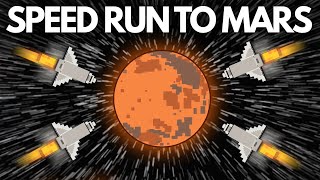(单词翻译:单击)
Hey there! Welcome to Life Noggin. Everyone always wants to get to Mars.
大家好!欢迎来到脑洞大开的生命奇想。每个人都想去火星。
Unfortunately, the journey would be a long one,
不幸的是,这个旅程将会很长,
taking hundreds of days of travel with our current technology.
用我们现在的技术的话,需要几百天的旅行。
Well, what if we could shorten that time to only a matter of days
如果我们不用我们的宇宙飞船,使用已经在太空中飞驰的东西,
by throwing away our spaceships and using something that's already zooming across space?
可以把这段时间缩短到几天呢?
I'm talking about comets. Comets are big ol' cosmic snowballs, made from frozen gases, rock,
我说的是彗星。彗星是巨大的宇宙球体,由冻结的气体、岩石、灰尘组成。
and dust that end up orbiting the Sun after the other planets tried throwing them at Earth and missed.
它们是在其他行星试图将其发射向地球但未命中后,最终绕太阳运行的星体。
Well, that last part probably isn't true. Everyone knows that the planets only have water gun battles.
好吧,最后那部分可能不是真的。每个人都知道行星上只有水战。
Not to mention, comets can actually be pretty big.
更不用说,彗星实际上可以非常大,
Frozen, you could probably liken them to about the size of a small town.
呈冻结状态,它们的大小大致和一个小镇相当。
However, when these things get close to the Sun in their orbit, they can begin to heat up.
然而,当这些东西在它们的轨道上接近太阳时,它们就会开始升温。
Then they start spewing dust and gases, forming a giant glowing head. Huh.
然后它们开始喷出灰尘和气体,形成一个巨大的发光的球。
I thought only I had that problem. Luckily enough, if we want to use one of these things for stellar travel, we have quite a few to choose from!
我以为只有我有这个问题。幸运的是,如果我们想在星际旅行中使用这些东西,我们有很多选择!
According to NASA, there are around 3,600 comets that we currently know of.
据美国国家航空航天局称,我们目前已知的彗星大约有3600颗。
Beyond that, it's believed that there are billions of other comets out there orbiting our Sun in the Kuiper Belt and even more distant Oort Cloud.
除此之外,据说,在柯伊伯带和更远的奥尔特云还有数十亿颗其他彗星围绕着我们的太阳运行。
What makes comets great for getting around in space is that they can go SUPER fast.
彗星之所以适合在太空中穿行,是因为它们的速度非常快。
Yeah, this baby can fly! How fast they're travelling depends on a bunch of different factors,
是的,这个宝宝会飞!它们的速度取决于很多不同的因素,
but they can travel anywhere from a few thousand kilometers per hour, to over 160,000 kilometers per hour under certain conditions.
但它们可以以每小时几千公里的速度移动,在某些条件下可以达到每小时16万公里以上。
In fact, in 2016, scientists at NASA recorded a comet traveling at nearly 600 kilometers per second as it dove toward the Sun.
事实上,在2016年,美国国家航空航天局的科学家们记录了一颗以每秒近600公里的速度冲向太阳的彗星。

That's over 2 /million/ kilometers per hour!!!
速度超过了200万公里每小时!
To put that in perspective, if we could travel at 2 million kilometers per hour,
如果我们以每小时200万公里的速度飞行,
then we could get to Mars from Earth in around 28 hours,
然后我们可以在28小时内从地球到达火星,时间只比一天多一点,
just little more than a single day, assuming the two planets were close together in their orbits.
假设这两颗行星的轨道很近的话。
Lining up the planets is the least of our worries though.
然而,排列行星是我们最不需要担心的事情。
While comets can go super fast, getting to them would be a big problem.
虽然彗星的速度非常快,但要接近它们将是一个大问题。
That's because, not even considering how hard it would be to actually commandeer one,
那是因为,我们甚至不用考虑到征用一个彗星有多难,
comets just don't typically get that close to Earth.
因为彗星一般不会离地球那么近。
Hale-Bopp, a comet that made the news about two decades ago,
20年前制造了新闻的海尔-波普彗星,
came closer to Earth than most comets do, and it was still about 200 million kilometers away.
它比大多数彗星离地球更近,但仍然在2亿公里之外。
We might as well just go straight to Mars at that point!
那还不如直接去火星呢!
Even if a comet did come by Earth, we assume that its trajectory is towards Mars,
即使彗星确实经过地球,我们假设它的轨道是朝向火星的,
and we ignore that it would likely be in its more gassy, less-solid state, you'd still have to keep yourself alive on the comet.
而且我们忽略了它很可能是气态的,非固态的,你仍然需要在彗星上生存。
I guess if it's only a day or so then food and water would be less of an issue
我想如果只是一天左右,那么食物和水就不是问题了,
since the aliens would definitely feed you once we got there, but you'd still have to worry about oxygen and protecting yourself from space.
因为一旦我们到了那里,外星人肯定会给你食物,但你仍然要担心氧气和保护自己不受太空的伤害。
You would need about 0.84 kilograms of oxygen a day,
你将每天需要0.84千克的氧气,
so you better grab a spacesuit and take a big breath before jumping on the comet.
所以你最好在跳上彗星之前先穿上宇航服,深吸一口气。
So yeah, using comets as a means of space travel is probably not that viable in the end.
所以,使用彗星作为太空旅行的一种方式可能并不可行。
Sometimes I like doing these thought experiments, ya know, and then realizing that they can't work.
有时我喜欢做这些思维实验,你知道,然后发现它们行不通。
It's still interesting! That's how we learn people!
这仍然很有趣!我们就是这样了解人类的!
So do you have any questions about space that you want me to answer.
你们有关于太空的问题要我回答吗?
Any planets that we should cover next? Let me know right now in the comment section below!
接下来我们要讲什么行星?请立即在下面的评论区告诉我!
Curious to know what would happen if you were trapped on the international space station?
想知道如果你被困在国际空间站会发生什么吗?
We teamed up with our friend William Osman to answer that question. ISS actually gets its power from solar arrays made up of thousands of solar cells.
我们和我们的朋友威廉·奥斯曼合作来回答这个问题。实际上,国际空间站的能量来自于由成千上万个太阳能电池组成的太阳能电池阵列。
These arrays can efficiently covert solar energy into electrical power.
这些电池阵列可以有效地将太阳能转换成电能。
Typically producing more power than the station needs at one time.
通常在同一时间产生比空间站需要的更多的能量。
As always, my name is Blocko, this has been Life Noggin, don't forget to keep on thinking!
我是宝高,这里是脑洞大开的生命奇想!不要忘记思考!


